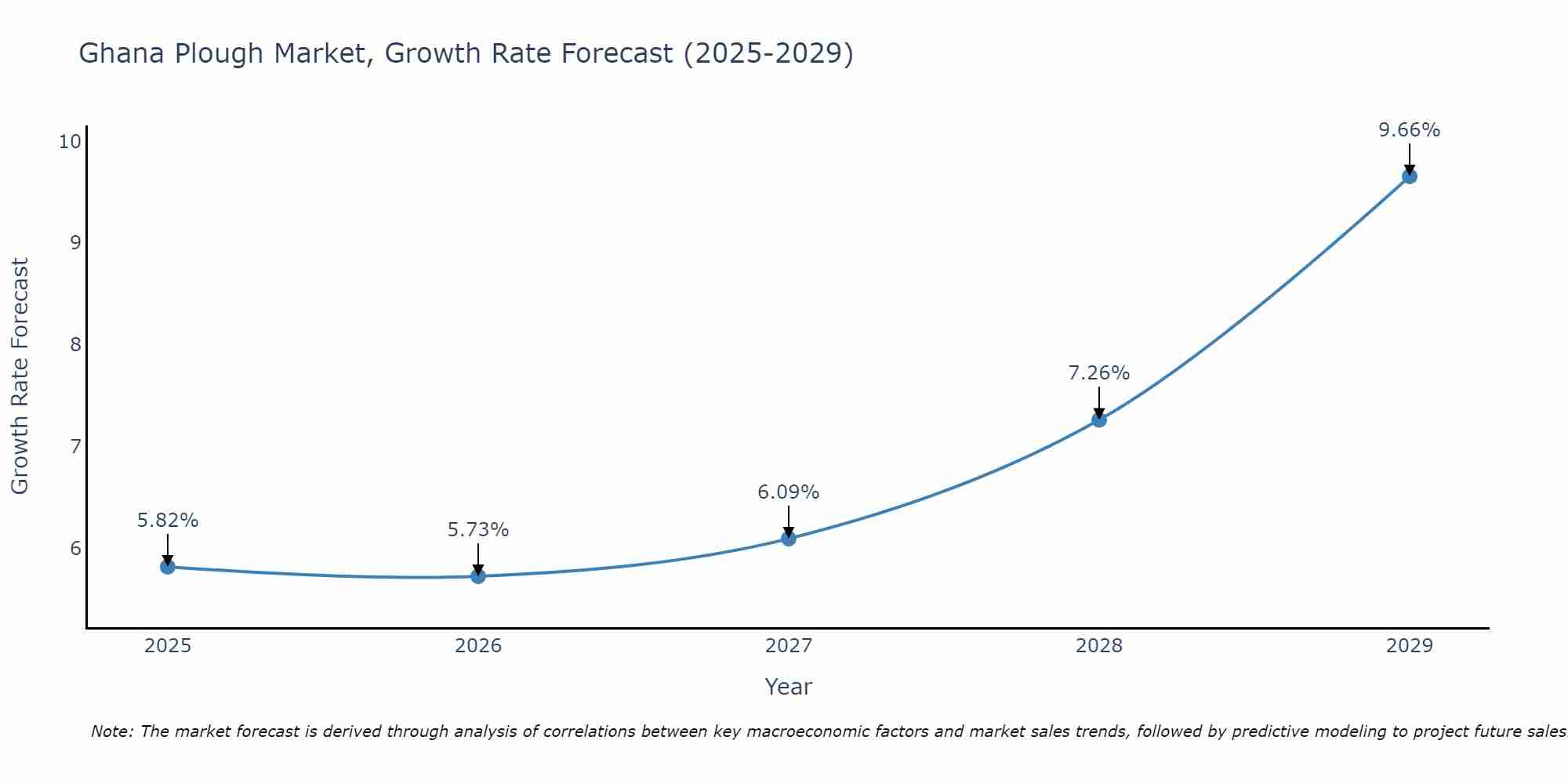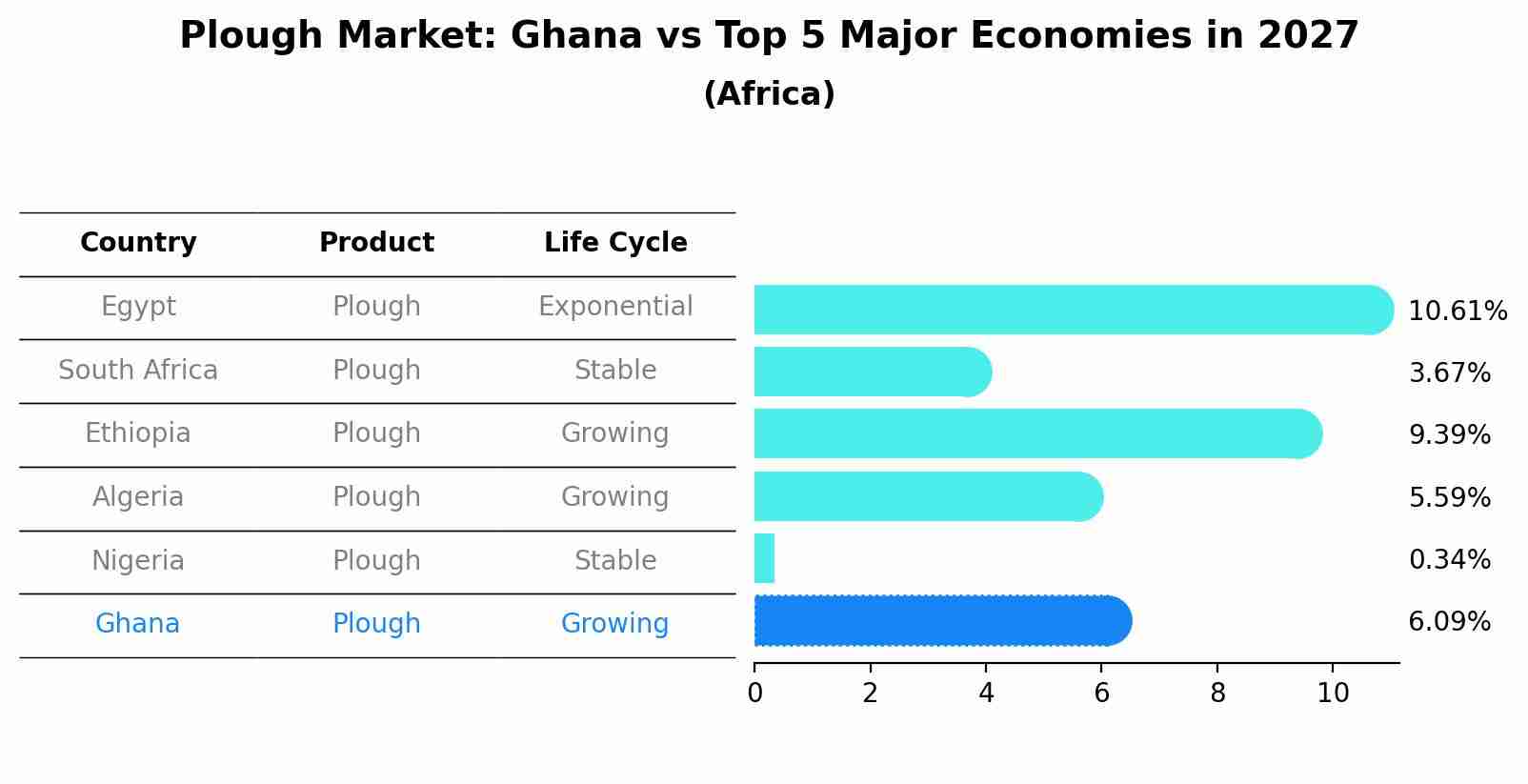Ghana Plough Market (2025-2031) | Forecast, Industry, Trends, Value, Size, Companies, Analysis, Share, Revenue, Growth & Outlook
| Product Code: ETC051516 | Publication Date: Jan 2021 | Updated Date: Jun 2025 | Product Type: Report | |
| Publisher: 6Wresearch | Author: Shubham Padhi | No. of Pages: 70 | No. of Figures: 35 | No. of Tables: 5 |
Ghana Plough Market Size Growth Rate
The Ghana Plough Market is projected to witness mixed growth rate patterns during 2025 to 2029. The growth rate starts at 5.82% in 2025 and reaches 9.66% by 2029.

Plough Market: Ghana vs Top 5 Major Economies in 2027 (Africa)
By 2027, Ghana's Plough market is forecasted to achieve a growing growth rate of 6.09%, with Egypt leading the Africa region, followed by South Africa, Ethiopia, Algeria and Nigeria.

Ghana Plough Market Overview
The Ghana plough market is a thriving sector within the agricultural industry, driven by the country`s significant reliance on traditional ploughing methods for farming activities. The market offers a variety of plough types, including ox-drawn, tractor-mounted, and hand ploughs, catering to the diverse needs of smallholder farmers and larger agricultural operations. Key players in the market include local manufacturers producing affordable ploughs for small-scale farmers, as well as international companies offering advanced ploughing technologies for commercial farming enterprises. The market is characterized by increasing mechanization efforts to improve efficiency and productivity in the agricultural sector. Factors such as government support, technological advancements, and the growing awareness of sustainable farming practices are expected to drive further growth and innovation in the Ghana plough market in the coming years.
Ghana Plough Market Trends
In the Ghana plough market, there is a growing trend towards mechanization and modernization as agriculture becomes more commercialized. Farmers are increasingly seeking more efficient and productive tools to cultivate their land, leading to a higher demand for tractor-mounted ploughs and other mechanized equipment. Additionally, there is a shift towards sustainable farming practices, with a focus on conservation tillage techniques that reduce soil erosion and improve soil health. This trend is driving the adoption of conservation ploughs and disc ploughs in the market. Furthermore, there is a rising interest in adjustable ploughs that offer flexibility in terms of depth and width, allowing farmers to customize their ploughing operations according to their specific needs and soil conditions. Overall, the Ghana plough market is witnessing a shift towards mechanization, sustainability, and customization to meet the evolving needs of modern farmers.
Ghana Plough Market Challenges
In the Ghana plough market, several challenges are faced by both manufacturers and consumers. One significant challenge is the inconsistency in the supply chain, leading to fluctuations in product availability and pricing. This inconsistency is often attributed to factors such as unpredictable weather conditions, inadequate infrastructure, and limited access to financing for manufacturers. Additionally, the lack of standardization in plough design and quality control poses a hurdle for consumers in selecting reliable products. Furthermore, competition from imported ploughs, often of lower quality but lower price, adds pressure on local manufacturers. To address these challenges, stakeholders in the Ghana plough market need to focus on improving supply chain efficiency, enhancing product quality, and promoting domestic manufacturing through supportive policies and incentives.
Ghana Plough Market Investment Opportunities
Investment opportunities in the Ghana plough market include the potential for manufacturers to expand their production capacity to meet the growing demand for ploughs in the agriculture sector. Additionally, there is an opportunity for investors to introduce innovative and more efficient plough designs to cater to the evolving needs of farmers. Partnerships with local distributors and retailers can also be explored to enhance market penetration and reach more customers. Furthermore, investing in technology and digital solutions for plough distribution and sales could streamline operations and improve overall efficiency in the market. Overall, the Ghana plough market presents opportunities for growth and development through product innovation, market expansion, and technological advancements.
Ghana Plough Market Government Policy
The Ghanaian government has implemented various policies aimed at regulating the plough market in the country. These policies include setting standards for plough manufacturing to ensure quality and safety, providing subsidies to farmers to encourage the adoption of modern ploughing techniques, and promoting sustainable agricultural practices through the use of environmentally friendly ploughs. Additionally, the government has introduced initiatives to support local artisans and manufacturers in the production of ploughs, aiming to boost the domestic industry and reduce reliance on imported equipment. Overall, these policies are designed to improve agricultural productivity, enhance food security, and promote sustainable development in the Ghanaian farming sector.
Ghana Plough Market Future Outlook
The future outlook for the Ghana plough market is positive, driven by various factors such as increasing adoption of mechanized farming practices, government initiatives to promote agriculture, and rising demand for efficient and productive farming equipment. With the agricultural sector being a key contributor to Ghana`s economy, there is a growing focus on modernizing farming techniques to enhance productivity and meet the increasing food demand. This trend is expected to drive the demand for ploughs in the country, as farmers look to improve their efficiency and output. Additionally, the availability of advanced plough technologies and innovations tailored to the local agricultural landscape will further fuel market growth. Overall, the Ghana plough market is poised for expansion in the coming years, presenting opportunities for manufacturers and suppliers in the agricultural machinery sector.
Key Highlights of the Report:
- Ghana Plough Market Outlook
- Market Size of Ghana Plough Market, 2024
- Forecast of Ghana Plough Market, 2031
- Historical Data and Forecast of Ghana Plough Revenues & Volume for the Period 2021 - 2031
- Ghana Plough Market Trend Evolution
- Ghana Plough Market Drivers and Challenges
- Ghana Plough Price Trends
- Ghana Plough Porter's Five Forces
- Ghana Plough Industry Life Cycle
- Historical Data and Forecast of Ghana Plough Market Revenues & Volume By Types for the Period 2021 - 2031
- Historical Data and Forecast of Ghana Plough Market Revenues & Volume By Traditional Plough for the Period 2021 - 2031
- Historical Data and Forecast of Ghana Plough Market Revenues & Volume By Modern Plough for the Period 2021 - 2031
- Historical Data and Forecast of Ghana Plough Market Revenues & Volume By Specialist Plough for the Period 2021 - 2031
- Historical Data and Forecast of Ghana Plough Market Revenues & Volume By Application for the Period 2021 - 2031
- Historical Data and Forecast of Ghana Plough Market Revenues & Volume By Farm for the Period 2021 - 2031
- Historical Data and Forecast of Ghana Plough Market Revenues & Volume By Individual Farming for the Period 2021 - 2031
- Ghana Plough Import Export Trade Statistics
- Market Opportunity Assessment By Types
- Market Opportunity Assessment By Application
- Ghana Plough Top Companies Market Share
- Ghana Plough Competitive Benchmarking By Technical and Operational Parameters
- Ghana Plough Company Profiles
- Ghana Plough Key Strategic Recommendations
Frequently Asked Questions About the Market Study (FAQs):
1 Executive Summary |
2 Introduction |
2.1 Key Highlights of the Report |
2.2 Report Description |
2.3 Market Scope & Segmentation |
2.4 Research Methodology |
2.5 Assumptions |
3 Ghana Plough Market Overview |
3.1 Ghana Country Macro Economic Indicators |
3.2 Ghana Plough Market Revenues & Volume, 2024 & 2031F |
3.3 Ghana Plough Market - Industry Life Cycle |
3.4 Ghana Plough Market - Porter's Five Forces |
3.5 Ghana Plough Market Revenues & Volume Share, By Types, 2024 & 2031F |
3.6 Ghana Plough Market Revenues & Volume Share, By Application, 2024 & 2031F |
4 Ghana Plough Market Dynamics |
4.1 Impact Analysis |
4.2 Market Drivers |
4.3 Market Restraints |
5 Ghana Plough Market Trends |
6 Ghana Plough Market, By Types |
6.1 Ghana Plough Market, By Types |
6.1.1 Overview and Analysis |
6.1.2 Ghana Plough Market Revenues & Volume, By Types, 2016 - 2031F |
6.1.3 Ghana Plough Market Revenues & Volume, By Traditional Plough, 2016 - 2031F |
6.1.4 Ghana Plough Market Revenues & Volume, By Modern Plough, 2016 - 2031F |
6.1.5 Ghana Plough Market Revenues & Volume, By Specialist Plough, 2016 - 2031F |
6.2 Ghana Plough Market, By Application |
6.2.1 Overview and Analysis |
6.2.2 Ghana Plough Market Revenues & Volume, By Farm, 2016 - 2031F |
6.2.3 Ghana Plough Market Revenues & Volume, By Individual Farming, 2016 - 2031F |
7 Ghana Plough Market Import-Export Trade Statistics |
7.1 Ghana Plough Market Export to Major Countries |
7.2 Ghana Plough Market Imports from Major Countries |
8 Ghana Plough Market Key Performance Indicators |
9 Ghana Plough Market - Opportunity Assessment |
9.1 Ghana Plough Market Opportunity Assessment, By Types, 2024 & 2031F |
9.2 Ghana Plough Market Opportunity Assessment, By Application, 2024 & 2031F |
10 Ghana Plough Market - Competitive Landscape |
10.1 Ghana Plough Market Revenue Share, By Companies, 2024 |
10.2 Ghana Plough Market Competitive Benchmarking, By Operating and Technical Parameters |
11 Company Profiles |
12 Recommendations |
13 Disclaimer |
- Single User License$ 1,995
- Department License$ 2,400
- Site License$ 3,120
- Global License$ 3,795
Search
Thought Leadership and Analyst Meet
Our Clients
Related Reports
- Germany Breakfast Food Market (2026-2032) | Industry, Share, Growth, Size, Companies, Value, Analysis, Revenue, Trends, Forecast & Outlook
- Australia Briquette Market (2025-2031) | Growth, Size, Revenue, Forecast, Analysis, Trends, Value, Share, Industry & Companies
- Vietnam System Integrator Market (2025-2031) | Size, Companies, Analysis, Industry, Value, Forecast, Growth, Trends, Revenue & Share
- ASEAN and Thailand Brain Health Supplements Market (2025-2031) | Strategy, Consumer Insights, Analysis, Investment Trends, Opportunities, Growth, Size, Share, Industry, Revenue, Segments, Value, Segmentation, Supply, Forecast, Restraints, Outlook, Competition, Drivers, Trends, Demand, Pricing Analysis, Competitive, Strategic Insights, Companies, Challenges
- ASEAN Bearings Market (2025-2031) | Strategy, Consumer Insights, Analysis, Investment Trends, Opportunities, Growth, Size, Share, Industry, Revenue, Segments, Value, Segmentation, Supply, Forecast, Restraints, Outlook, Competition, Drivers, Trends, Demand, Pricing Analysis, Competitive, Strategic Insights, Companies, Challenges
- Europe Flooring Market (2025-2031) | Outlook, Share, Industry, Trends, Forecast, Companies, Revenue, Size, Analysis, Growth & Value
- Saudi Arabia Manlift Market (2025-2031) | Outlook, Size, Growth, Trends, Companies, Industry, Revenue, Value, Share, Forecast & Analysis
- Uganda Excavator, Crane, and Wheel Loaders Market (2025-2031) | Strategy, Consumer Insights, Analysis, Investment Trends, Opportunities, Growth, Size, Share, Industry, Revenue, Segments, Value, Segmentation, Supply, Forecast, Restraints, Outlook, Competition, Drivers, Trends, Demand, Pricing Analysis, Competitive, Strategic Insights, Companies, Challenges
- Rwanda Excavator, Crane, and Wheel Loaders Market (2025-2031) | Strategy, Consumer Insights, Analysis, Investment Trends, Opportunities, Growth, Size, Share, Industry, Revenue, Segments, Value, Segmentation, Supply, Forecast, Restraints, Outlook, Competition, Drivers, Trends, Demand, Pricing Analysis, Competitive, Strategic Insights, Companies, Challenges
- Kenya Excavator, Crane, and Wheel Loaders Market (2025-2031) | Strategy, Consumer Insights, Analysis, Investment Trends, Opportunities, Growth, Size, Share, Industry, Revenue, Segments, Value, Segmentation, Supply, Forecast, Restraints, Outlook, Competition, Drivers, Trends, Demand, Pricing Analysis, Competitive, Strategic Insights, Companies, Challenges
Industry Events and Analyst Meet
Whitepaper
- Middle East & Africa Commercial Security Market Click here to view more.
- Middle East & Africa Fire Safety Systems & Equipment Market Click here to view more.
- GCC Drone Market Click here to view more.
- Middle East Lighting Fixture Market Click here to view more.
- GCC Physical & Perimeter Security Market Click here to view more.
6WResearch In News
- Doha a strategic location for EV manufacturing hub: IPA Qatar
- Demand for luxury TVs surging in the GCC, says Samsung
- Empowering Growth: The Thriving Journey of Bangladesh’s Cable Industry
- Demand for luxury TVs surging in the GCC, says Samsung
- Video call with a traditional healer? Once unthinkable, it’s now common in South Africa
- Intelligent Buildings To Smooth GCC’s Path To Net Zero


















